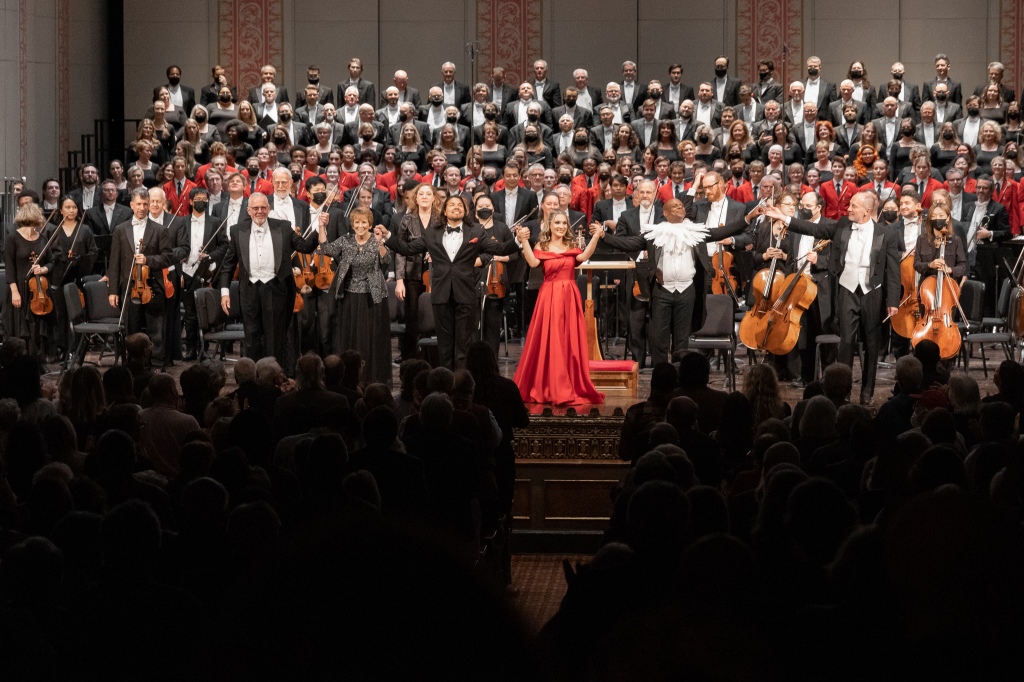Columbus Symphony Orchestra
Rossen Milanov, conductor
Ashley Fabian, soprano
Arthur W. Marks, tenor
Ethan Vincent, baritone
Columbus Symphony Chorus
Ronald J. Jenkins, chorus director
Columbus Children’s Choir
Jeanne Wohlgamuth, artistic director
Ohio Theatre
Columbus, OH
September 30, 2022
Orff: Carmina Burana
There’s only a handful of works from the twentieth century and later that generate an enduring popular appeal, and Orff’s 1937 cantata Carmina Burana is certainly one of them. A choice opener for the Columbus Symphony’s 2022-23 season, it also marked the first full-fledged return of the Chorus post-pandemic, having been relegated to more minor roles in the handful of repertoire last season that called for chorus. Adding to the sense of occasion on opening night was the presence of the League of American Orchestras CEO Simon Woods and Ohio Lt. Governor Jon Husted, introduced by CSO executive director Denise Rehg.

The chorus is certainly the star of Carmina Burana, evident from the onset with the iconic “O Fortuna” that set the dramatic tone sustained for the remainder of the work. Finely prepared by Ronald J. Jenkins in his final season as chorus director, they negotiated no less than three languages – and dead languages at that: Latin, Middle High German, and Old French. The choral scoring more often than not puts the chorus in unison, and a strophic structure dominates, maximizing a directness of expression – this isn’t a work where one gets lost in a web of contrapuntal intricacies. Still, there were times where one wanted better projection over the large orchestra and greater clarity of diction (the texts and translations were fortunately provided in the program books).
It wasn’t all drama and bombast, however, with “Veris leta facies” bringing to life gentler, vernal delights, and the Round Dance sharply contrasting bacchanalia with the more introspective. The Columbus Children’s Choir under the direction of Jeanne Wohlgamuth offered a further choral layer in this lavish tapestry, almost angelic when in dialogue with soprano Ashley Fabian in “Amor volat undique.” Fabian was fittingly clothed in red, evoking the titular red tunic of “Stetit puella rufa tunica,” and served as a fitting foil to her male counterparts. She boasted an impressive command of labyrinthine melismas in “Dulcissime, totam tibi subdo me!”
Tenor Arthur W. Marks appeared offstage (and feathered) in “Olim lacus colueram”, dramatically one of the most striking moments of the work, singing high into his range in a pained dialogue with the masses of the chorus, although I felt the sense of tortured struggle could have been conveyed even more convincingly. I found baritone Ethan Vincent – who last appeared on this stage as Marcello in in La bohème – the most compelling of the trio of soloists. His first appearance in “Omnia Sol temperat” was given with charismatic delivery, and subsequently, he lumbered onstage, pantomiming inebriation in “Estuans interius” – yet ultimately, his delivery bordered on a sumptuousness more fit for Puccini. His command of the wide range demanded in “Dies, nox et omnia”, however, was where he was truly a standout.
Though the chorus rightly deserves the spotlight, the extensive orchestral forces were certainly an entity to be reckoned with. The dance movement for orchestra alone that opens “Uf dem anger” was given a vigorous workout, capped off with a silvery flute solo. “Were diu werlt alle min” was bursting with brassy splendor. The piano (Caroline Hong) features quite prominently in the score, perhaps most strikingly in “Veni, veni, venias.” The occasional uncoordinated entrance notwithstanding, music director Rossen Milanov commanded the disparate forces as a unified whole for a satisfying first entry of the season. As noted in both the program notes and Christopher Purdy’s preconcert lecture, Carmina Burana is in fact the first in a trilogy of related works. Despite the popularity of the first, the latter two remain largely uncharted territory – a potentially fascinating exploration for the CSO to undertake in future seasons.
